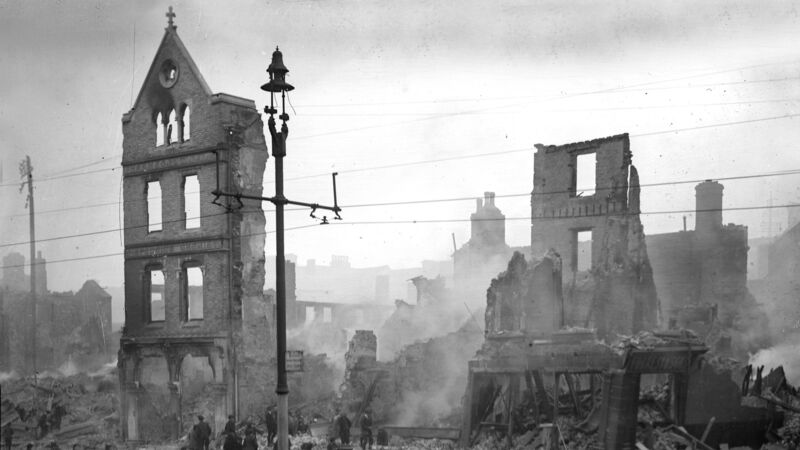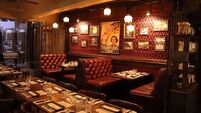The Burning of Cork: A message of hope from the embers 100 years on

Crowds of onlookers throng St Patrick St on the day following the burning of Cork City centre by crown forces. Ref. 303
Right now, it feels as if we are wading through treacle, and that is putting it mildly. People are fed up. You can sense it in the air. Christmas is not going to be anything like last year; there can be little doubt about that.
It might be an idea, then, not to compare this lacklustre December to the sparkle of recent years but to compare it to a more distant — and arguably much more difficult — past. That is not to downplay the many challenges of the present, just to acknowledge the unexpected comfort that comes with knowing we are not the first to face hard times.
Indeed, 2020 with its perfect storm of Covid-19 and the shadow of Brexit does not look quite so bad, or unique, when you look back through the perspective-adjusting lens of history.
And as we are in this decade of centenaries, let’s fix that lens on 1920 when, 100 years ago next week, Auxiliaries burned out the commercial centre of Cork City in reprisal for an IRA ambush.
In the coming days, many will mark the centenary of December 11/12, that “night of horror”, as this paper described it, when “residents in every part of the city were terrified by the rifle and revolver firing, bomb explosions, extensive outbreaks of fire, the breaking and smashing of windows and business premises and crashing of walls of buildings”.
More than 40 shops were destroyed, five acres of property worth £20m were destroyed, and thousands of people lost their jobs.
The smouldering ruins were vividly described by Sinn Féin representative Liam de Róiste when he walked through the city the next morning.
He saw “an orgy of destruction and ruin: the calm sky frosty red — red as blood with the burning city, and the pale cold star looking down on the scenes of desolation and frightfulness”.
Accounts from the time capture the prevailing atmosphere of fear, the mistrust, and the constant threat of attack and reprisal. Civilians walking on the street were warned not to congregate and to keep their hands out of their pockets so that they could not hide weapons.
The city, and the country as a whole, was still reeling after the devastating effect of the Spanish flu which killed an estimated 23,000 Irish people between 1918 and 1919.
There was still a risk of getting typhoid fever, but J Pigott and Son, hair specialist at 35 Marlboro St, purported to be able to help those “troubled with falling hair or bald patches after typhoid fever or other illnesses”.
Yet, for all the hardship, the pages of this newspaper also tell the story of something else — the extraordinary resilience of the city’s traders and a population ready to help them to get back to normal as soon as possible.
The first edition of the to appear after the destruction of the city, on December 13, carried a front-page notice from jewellers and silversmiths Wm Egan & Sons that read: “Enquiries & orders are being attended to as usual.”
Another notice followed soon afterwards to say the business had moved temporarily from number 32, Patrick St to the Victoria Hotel on the corner of Patrick St and Cook St. The hotel had suffered only minor smoke damage as it had its own fire-fighting equipment.
The next day, December 14, several businesses booked space to repeat the same message — it was business as usual and customers could rest assured that their Christmas orders would be delivered on time.
Messrs W & T Evans, 11, Patrick St, Cork, wished to “return thanks to the brave Cork Firemen who saved their Premises, and the unknown Reverend Gentleman who so ably helped to board up their shattered windows early on Sunday morning, and the general public who also kindly assisted”.
The following day, Roches Stores Ltd, Merchant St, thanked the firemen and all voluntary helpers for saving part of their premises at great risk to themselves: “They deserve more than our thanks, but that is all we can give them at present.
"We will be open again on Thursday morning, and we ask the public for a continuance of their confidence."
Others, such as Haynes and Sons, at 51, Patrick St, asked their customers to be patient, explaining that they believed “all watches and jewellery left for repairs [were] safe, but it will be some little time before they can be sorted out”.
Temporary shops and huts were established as traders awaited compensation while others cordoned off undamaged parts of existing buildings. J W Dowden & Co Ltd, one of Cork’s oldest shops, moved to a large department at the back of their store where they assembled a range of “suitable gifts” for Christmas.
We tend to think that our own difficulties are unique but look back through the pages of history and you soon begin to realise that they are the very thing that make us human. American writer James Baldwin put it much more eloquently when he said: “You think your pain and your heartbreak are unprecedented in the history of the world, but then you read. It was books that taught me that the things that tormented me most were the very things that connected me with all the people who were alive, or who had ever been alive."
For me, it is history that provides a touchstone to all of humanity. While you cannot filter the past through the values of today, you cannot but be moved by the benevolent collective energy that flows through the small ads and the notices published in this paper 100 years ago.
We have seen that kind of solidarity in recent times too but, as the second lockdown eased yesterday, there also seemed to be a growing weariness captured in new Central Statistics Office figures showing the numbers feeling downhearted or depressed had increased from 5.5% in April to 11.5% now.
Even if there is much to celebrate — the promise of a vaccine, falling infection rates, the easing of restrictions — there is no point in playing the Pollyanna card and suggesting all is well either. People are facing immense challenges in every area of their daily lives.
That is why it can be helpful to look back and see that we are not the first to experience adversity and, it seems reasonable to suggest, we do not have it anywhere near as bad as the people who lived through the turbulence of the 1920s.
They have much to tell us. We can, if we are so-minded, take a message of hope from their indomitable spirit. Or take some inspiration from the solidarity that shines through when disaster strikes.
But, if nothing else, looking back reminds us of one unassailable and consoling fact: this too shall pass.












